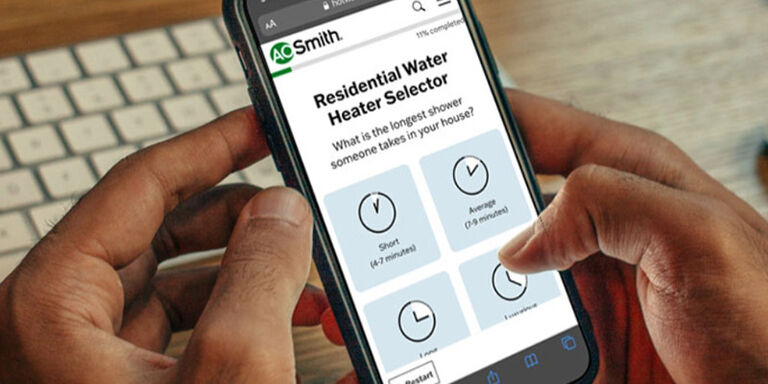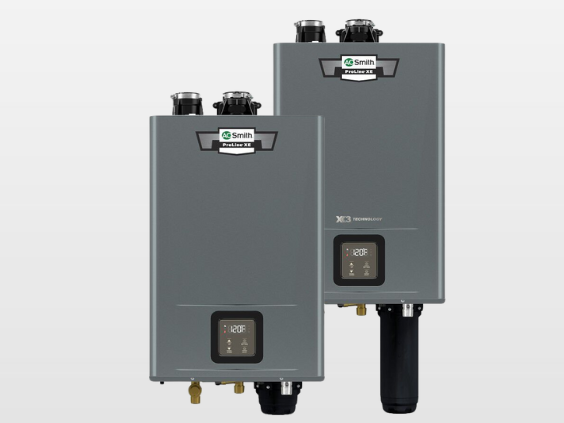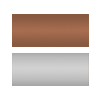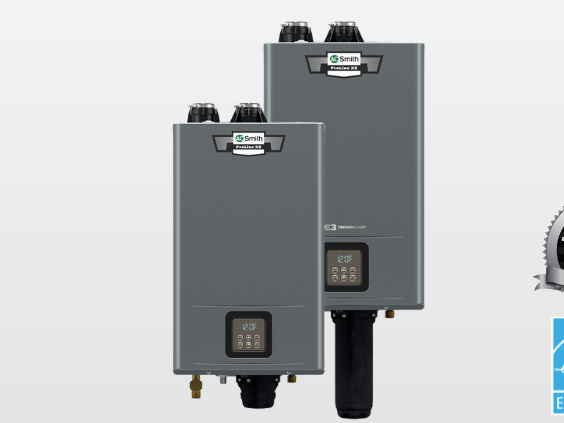.jpg?cx=1265&cy=0&cw=468&ch=625)
Tankless Water Heater Buying Guide
Gas tankless water heaters heat water more efficiently than most tank heaters, providing continuous hot water while using less energy over time. This buying guide walks you through the ins and outs of these units and how to choose a tankless water heater that’s right for your household needs.
Article Summary
Gas tankless water heaters heat water on demand, providing continuous hot water while using up to 40% less energy than traditional tank models. The right unit depends on flow rate (how many gallons per minute you need), temperature rise based on your local climate, and whether gas or electric makes more sense for your home. Condensing models capture exhaust heat for better efficiency and ENERGY STAR® certification, while non-condensing models have a lower starting price. A. O. Smith's tankless systems include X3® Scale Prevention Technology that eliminates the annual descaling maintenance most tankless brands need, which typically costs around $200 per year. Sizing matters because it determines whether you'll have enough hot water during busy times, and these units generally last about 20 years with basic upkeep like cleaning the filter and checking ventilation annually.
What is a Tankless Water Heater?
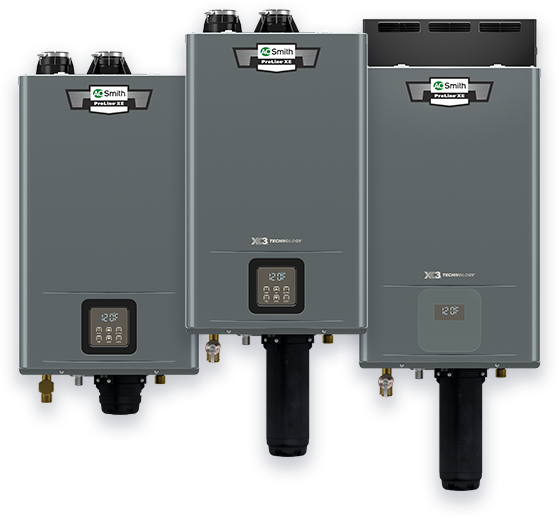
A tankless water heater, heats water only when you need it. , and it can heat water for your entire home or just a single point, such as hot water for a shower, a sink or an appliance. These water heaters allow installation in out-of-the-way spaces like in a closet or on an exterior wall.
Before you start comparing specific models, you'll need to make two key decisions that will narrow down your options and ensure you get a tankless water heater that works with your home's setup.
1.Selecting a Power Source
Tankless water heaters are designed to provide an endless source of hot water when sized properly, all while saving you money on energy costs by not storing, heating and reheating the same water. They come in natural gas, propane or electric models, so you can choose the model that fits the energy source you already have and your personal preferences
2.Deciding on Condensing or Non-Condensing
What is the difference between condensing and non-condensing gas tankless models? Condensing gas tankless water heaters capture and reuse heat from exhaust gases, making them more energy-efficient. Non-condensing models vent exhaust gases directly outside, which wastes some of that heat. Condensing systems cost more upfront but deliver better efficiency and lower operating costs over time.
How Does a Tankless Water Heater Work?
When you open a hot water tap or start the dishwasher, tankless water heaters recognize the need for hot water and start the heating process. The unit then calculates the incoming water temperature and uses it to determine how much heat the burners or elements must produce to deliver water at the desired temperature. Once demand ceases, the tankless water heater shuts down and stops using energy, waiting until you need more hot water to start heating again. The end result is that you’re no longer limited to the amount of hot water available in your tank.
Benefits of a Tankless Water Heater
A tankless water heater can turn any water source into hot water because it doesn’t limit you to the amount a storage tank heater can hold. Whether you're washing the dishes, laundering clothing and towels, or drawing a hot bath, tankless water heater technology supplies the hot water your lifestyle demands.
Lower Energy Bills
Take advantage of up to 40% energy savings with a tankless water heater compared to a standard gas tank water heater*. These units have a highly efficient design because they only heat water when needed.
Longevity
Tankless water heaters typically last up to 20 years with proper maintenance, which is often twice as long as a typical tank-style unit. The expanded lifespan means you typically spend less money on repairs and replacements.
Space Savings
Traditional water heaters can take up to 16 square feet of valuable floor space. Many tankless water heaters are about the size of a carry-on suitcase, and you can install these units on the wall inside or outside your home, freeing up valuable storage space
Choosing the Right Tankless Water Heater
Nothing beats a tankless water heater when you need hot water on demand. How to pick a tankless water heater that’s right for your home, however, requires a little forethought. That’s why determining what size tankless water heater you need is important. Water heaters that are too small typically don’t provide an adequate amount of hot water for your home’s needs, while a unit that is too large means unnecessary costs.
With that in mind, choose a tankless water heater that can easily handle peak hot water demand. For example, you want to select a unit that can deliver ample hot water for a running dishwasher, a leisurely shower and a load of laundry simultaneously. To do this, you need to know how much incoming water the tankless water heater needs to heat to take care of the demand. That’s where understanding the flow rate and desired temperature rise come in.
The flow rate measures the amount of water that flows from a fixture or appliance in gallons per minute (GPM). Likewise, temperature rise is the difference between the groundwater temperature and the desired hot-water output temperature. When it’s time to buy a tankless water heater, arm yourself with the flow rate and temperature rise, but also look at sizing charts and consider your overall budget to guide you in choosing the best unit to suit your needs.
Flow Rate (GPM)
To determine your hot-water needs, you need to figure out how many devices the water heater needs to support. To do this, list the total number of appliances or fixtures you typically use simultaneously during peak demand, such as washing dishes in the kitchen sink, doing a load of laundry and showering at the same time. Once you’ve decided how much on-demand hot water you need, add up each individual flow rate for the total flow rate.
Check the manufacturer’s manual for the fixture or appliance (shower head, dishwasher, washing machine, etc.) for the flow rate, or check for the GPM stamped directly on the item. You can also easily calculate the GPM of an appliance or fixture with a bucket and timer using the following formula: 60 divided by the number of seconds it takes to fill a 1-gallon container with water from the appliance or fixture.
Average GPM Usage for Common Appliances and Fixtures
Based on the chart above, the total flow rate for peak usage while using the shower, kitchen sink and a high-efficiency washing machine is 6.0 GPM.
Temperature Rise
Groundwater temperature varies throughout the country and can range from the mid-30s to the upper 70s, measured in Fahrenheit. North America is broken into three climate zones with average groundwater temperatures:
- Northern Zone: 37 degrees to 51 degrees
- Central Zone: 52 degrees to 61 degrees
- Southern Zone: 62 degrees to 77 degrees
Typical internal home water temperature ranges from 110 degrees to 120 degrees. To determine the temperature rise, subtract the incoming water temperature from the desired internal water temperature. For example, if the incoming water temperature is 57 degrees and your desired shower water temperature is 120 degrees, the temperature rise is 63 degrees.
Your Budget
Keep in mind that tankless water heaters are typically more expensive than their conventional counterparts. While traditional water heaters usually run between $500 and $2,000, tankless water heaters typically start at around $1,000 and go up from there. These units do, however, save you money over time in energy, maintenance and repair costs, so buying a tankless water heater may be the more economical option for many homes.
The cost of tankless water heater installation will depend on whether your home is already designed to support a tankless water heater or if your plumbing system will need to be upgraded. The average tankless water heater installation can range from $900 - $3,000.
Types of Tankless Water Heaters
There are a few different types of tankless water heaters available. Here’s an explanation of two common options so you can decide which is best for your needs.
Point of Use Water Heaters
Sometimes, an area of your home needs an extra boost of hot water. That's where a compact point-of-use comes in. For example, if you have a hot tub that uses electric heat, a point-of-use water heater can be installed nearby. These small, tankless heaters are installed near a room or appliance that needs additional hot water. These units are also helpful for additions/expansions to an existing home, and can often be installed in a cabinet or other small space.
To save space, select units that install easily in cabinets and compact closets. You can also buy electric tank water heaters and tankless natural gas or propane water heaters that utilize point-of-use technology for added flexibility in installation and added convenience.
Good to Know
You can find point of use electric tank water heaters and point of use tankless gas water heaters.
Whole Home Tankless Water Heaters
There are a range of gas and electric tankless water heaters designed to deliver enough hot water for a household.
Gas tankless water heaters range in sizes are available, from 140,000 BTU - 199,000 BTU, depending on the amount of hot water needed for a home or business. Whole home electric tankless tankless water heaters are available with a 240 volt, with kilowatt (kW) ranges of 14 - 32 kw. The higher the kilowatt, the more hot water can be delivered to a home or business.
Gas vs. Electric Tankless Water Heaters
Gas tankless water heaters can handle more hot water at once, which makes them a better choice if your family often uses multiple showers, runs the dishwasher, and does laundry all at the same time. They also keep working during power outages and usually cost less to run each month if you already have a gas line to your home.
Electric tankless models work well for smaller households or for heating water at a single location, like an extra bathroom. They're easier to install because they don't need venting, but your electrician might need to upgrade your electrical panel or add new circuits.
Your local climate matters too. When it's cold outside, the water coming into your home is much colder, so any tankless water heater has to work harder to heat it up. This means you might get less hot water flow during the winter months, especially in northern states.
Condensing vs. Non-Condensing Gas Tankless Water Heaters
Condensing models capture heat from exhaust gases and use it to warm up the water coming into your home. This extra step makes them work much more efficiently. A. O. Smith's condensing tankless water heaters hit .95 UEF efficiency and earn ENERGY STAR® certification, which means you'll pay less on your gas bill each month. They also use 2-inch venting that can make installation easier compared to older systems.
Non-condensing models cost less to buy and use a simpler heating setup with just one heat exchanger instead of two. They're a good starting point if you want a tankless water heater without paying for the premium efficiency features.
A. O. Smith's X3® Scale Prevention Advantage
All A. O. Smith ADAPT® condensing tankless models come with X3® Scale Prevention Technology built right in. This system stops mineral buildup automatically, so you never have to schedule annual descaling appointments like you would with most other tankless brands. Those maintenance visits can be pricey. With X3® technology, you skip that cost completely. A. O. Smith backs this feature with a 15-year warranty that covers any problems caused by scale buildup.
How to Install a Tankless Water Heater
If you have basic plumbing and electrical knowledge, you can install the tankless water heater you select yourself. Start by choosing a location for the unit that’s near both a water inlet and an electrical or gas connection. Next, shut off the power, or gas and water supply to the area and disconnect your old water heater. Prep your new tankless water heater for installation per the manufacturer’s instructions, and install any new water lines necessary for operation. Double-check all the fittings to prevent leaks, then connect the unit to the power supply.
Next, install any ventilation required for the tankless water heater, and mount the unit in your desired location. Once secure, connect the water lines, purge any air left in the lines by running water for at least 3 minutes before turning the unit on, then it is safe to power back on. Now check to ensure the unit operates properly and make temperature adjustments as needed. Make sure to double-check all the lines and ventilation to ensure smooth operation. We recommend calling a professional installer to make sure the job is completed correctly.
Maintaining the Tankless Water Heater You Choose
Tankless water heaters need less maintenance than traditional tank models, but you should still handle a few basic tasks each year to keep your unit running efficiently and safely. Here are some must-do preventative maintenance tasks:
- Cleaning the filter: Tankless water heaters have inlet filters that keep debris out of the unit, and these filters require regular cleaning. Removing any debris reduces risks of clogging and ensures water flows through your unit uninterrupted.
- Monitor water pressure: Monitor the water pressure regularly to ensure it stays in the optimum range noted in the manufacturer’s guidelines.
- Inspect ventilation systems: If you pick a tankless water heater that uses natural gas or propane for power, you should check the ventilation system annually. Look for obvious problems like obstructions, blockages and loose connections, and inspect closely for signs of damage or corrosion.
- Descaling the water heater: Gas tankless water heaters will build up scale in the heat exchanger if the water is not treated. It is important to descale a tankless water heater when the flow rate starts to drop.
However, A. O. Smith ADAPT® condensing models with X3® Scale Prevention Technology eliminate this maintenance requirement completely. The X3® system handles scale prevention automatically, saving you time and the cost of annual descaling appointments.
When buying a tankless water heater, take into account the size of your house, the water-flow rate of your faucets, the temperature of the water before it heats up and how hot you want your water to be. With those calculations, a plumbing contractor can help you find the best tankless water heater for your home.
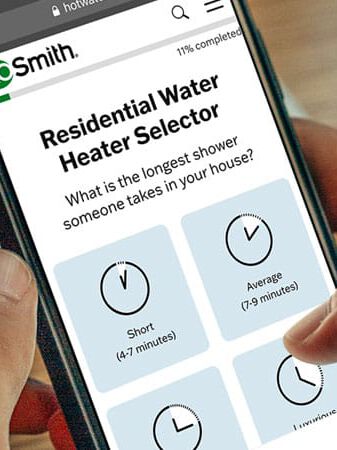
Not sure which product is right for you?
Take our water heater selector quiz to find the correct water heater for your home.
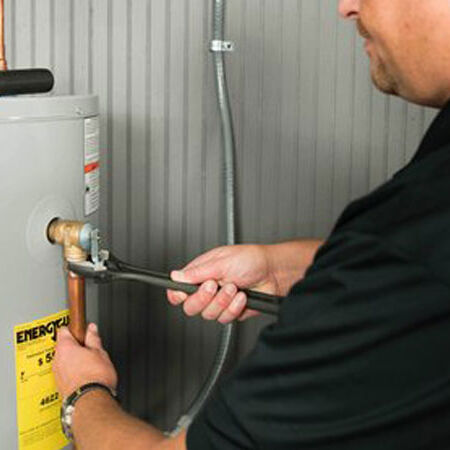
Find A Local Water Heater Pro
A. O. Smith water heaters are professionally installed by local independent contractors.
Frequently Asked Questions
If you want continuous hot water and lower energy bills, a tankless water heater makes sense for most homes. These units can save you up to 40% on water heating costs compared to standard tank models, and they typically last around 20 years with proper care.
Tankless water heaters use less energy because they only heat water when you turn on a faucet or appliance. Tank heaters constantly reheat stored water throughout the day, even when you're not using it. This means lower energy consumption and fewer greenhouse gas emissions. A. O. Smith's ENERGY STAR®-certified condensing models take this a step further with efficiency ratings up to .95 UEF.
The right size depends on how many people shower at the same time and what other hot water appliances run during your busiest hour. A family of six that takes back-to-back showers needs a different capacity than a family that has multiple people showering simultaneously while running the dishwasher. Use A. O. Smith's Water Heater Selector to get a recommendation based on your specific household habits—it takes just a few minutes and accounts for your local climate, too.
Why A. O. Smith?

A. O. Smith is a leading manufacturer of both residential and commercial water heating technologies, including the #1 most specified commercial water heater.

For more than 145 years, we’ve developed state-of-the art products that push new boundaries and improve the lives of our customers.

We combine cutting-edge technology with committed people who take pride in providing the very best support for our customers.

Our products are put through rigorous quality and endurance testing so no matter where hot water is needed, A. O. Smith can provide a solution you can count on.
